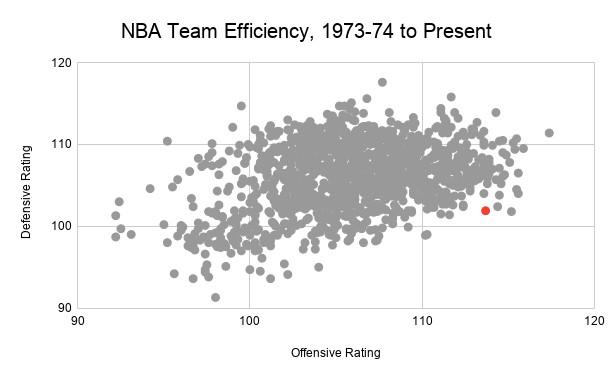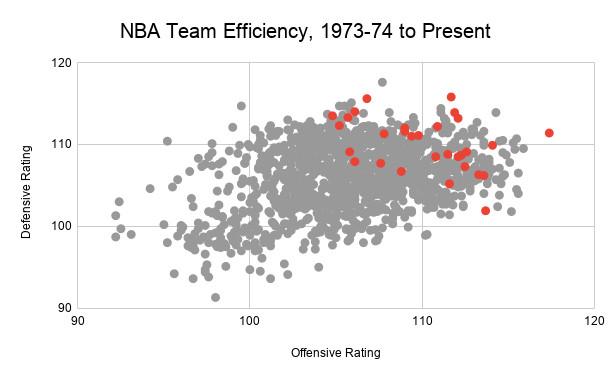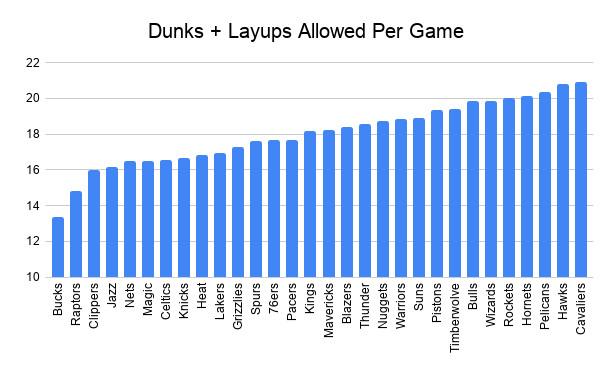
As befits a fast-paced and high-scoring era of NBA basketball, the fastest-paced and highest-scoring team in decades has the best record in the league. Milwaukee has parlayed its pace and points into a chance at 70 wins (schedule willing) and the best point differential in league history.
But for all the dynamism of the Bucks’ 120-points-per-game offense, led by Giannis Antetokounmpo and Khris Middleton and a host of shooters, the team’s defense is even more impressive. That claim seems somewhat specious at first; the Bucks regularly allow triple-digit scores, and their 101.9 defensive rating per Basketball-Reference is tied for just the 202nd-best mark since 1973-74 (when Basketball-Reference first calculates per-possession data). It’s an easy visual, too—the Bucks are the red dot on this graph, with a whole host of teams below them with a stingier defensive showing.

Mark every other 2019-20 club in red, however, and the gap between the Bucks and their peers grows remarkably apparent. Milwaukee allows 101.9 points per 100 possessions—no other team this season is below 105, and more than half are above 110. (That lone dot all the way on the right, by the way, represents this season’s Mavericks, on pace for the best offensive season in league history.)

In a high-offense era, the Bucks stand out because they’re the only defense resisting that trend. Milwaukee’s defense is 8.2 points per 100 possessions better than the NBA average this season. Adjusted for the difference in scoring eras, they’re one of the best defenses ever.
Best League-Adjusted Defenses, 1973-74 to Present
Moreover, the Bucks are 3.3 points per 100 possessions better than the second-best defense in the league (the Raptors). That differential is the second largest in league history, behind only the gap between the 1992-93 Knicks and second-place SuperSonics (5.2 points).
As in last season, when the Bucks also led the league in defensive rating—albeit with a less impressive mark of 105.2—this overperformance flows from a singular focus on controlling the area near the basket. The best at-rim defender this season, as measured by opposing field goal percentage, is Giannis Antetokounmpo (41.9 percent). The second best is Brook Lopez (46.0). The third best is Robin Lopez (46.4).
To be clear: Those three players aren’t just the best on the Bucks. They’re the three best at-rim defenders in the NBA.
This strategic focus opens up 3-point opportunities for the opponent. Indeed, no team allows more 3s per game than the Bucks. (Teams also take more against Milwaukee because they often need to catch up to a big Bucks lead.) And outside garbage time, Milwaukee ranks just 20th in opposing 3-point percentage.
But walling off the rim appears well worth the tradeoff for a few extra 3s allowed. The Bucks have allowed teams to shoot 41.1 percent from the field. Based on the specific players they’ve faced, however, they would be “expected” to allow 45.2 percent. That difference of 4.1 percentage points is nearly double the gap for the second-best team this season, and the highest on record in the player-tracking era (since 2013-14).
Milwaukee’s defensive success is a credit to more than just the specific talents of the reigning MVP and Lopez twins. The Bucks don’t just prevent teams from making shots near the rim—they prevent them from getting there in the first place.
As a team, the Bucks are allowing the lowest percentage of shots at the rim, and they’re allowing the lowest field goal percentage on shots in that area. The most fruitful spot on the court turns into a wasteland against Milwaukee.
The last team to pull off both feats was, well, the Bucks last season—the team’s first with coach Mike Budenholzer and Brook Lopez. But before Milwaukee, no team had done so since the 2006-07 Rockets, who had Yao Ming and Dikembe Mutombo patrolling the paint. (Let’s take a moment to acknowledge the utter delight of a franchise that somewhat recently had Ming and Mutombo, and now starts 6-foot-5 P.J. Tucker at center.)
Cleaning the Glass calculates a stat called “location effective field goal percentage” that asks “if this team allowed the league average FG% from each location, what would their opponents’ effective FG% be?,” which then “gives us a sense of the efficiency of a team’s defensive shot profile.” The Bucks rank third in this metric, narrowly behind Utah and Brooklyn—meaning they would still profile as an elite defense even if they didn’t also have the best defenders at altering shots at the moment of firing. Budenholzer’s game plan works.
A rim-centric defensive philosophy affords the Bucks more advantages than merely forcing opponents into lower-percentage shots; fewer shots near the basket mean fewer realistic opportunities for the opponent to draw a whistle or grab an offensive rebound. The Bucks don’t foul often, with the fourth-lowest opponent free throw rate, and they’re on pace for the best defending rebounding season in NBA history, with Giannis leading the league in defensive rebounds per game.
Granted, league context plays a large role here. There is an ongoing, decadeslong decline in offensive rebounds—49 of the top 50 teams in defensive rebounding rate have come since the 2014-15 season. But it’s still an all-time leaderboard, and the Bucks are still at the top.
Research presented at the 2012 Sloan Analytics Conference found the following offensive rebounding rates based on shot distance:
- From 0 to 6 feet, the offense rebounds 36 percent of missed shots
- From 6 to 10 feet, 28 percent
- From 10 to 22 feet, 21.5 percent
- Beyond 22 feet, 25.5 percent
Although 3-pointers yield a modest uptick in offensive rebounds, perhaps because longer shots tend to produce longer bounces off the rim, the best opportunities for offensive rebounds come after missed shots around the rim. And while that data comes from eight years ago, if anything, it appears that the offensive rebounding gap based on shot distance has widened since then. The Bucks thus make first chances harder on opposing offenses—and prevent them from gathering second chances to compensate for missed shots on the first.
One simple, related stat seems to identify the league’s best teams: the combined quantity of dunks and layups they allow. The top 10 teams in the stat this season, according to Basketball-Reference, comprise nine playoff squads and the Knicks (thanks to the Mitchell Robinson factor, perhaps?). But the Bucks, who have allowed both the fewest dunks and the fewest layups, are far and away the best team by this metric.

Despite the “defense wins championships” mantra, a staunch defense does not itself guarantee a title. Going back to that first chart, while some teams on the list ended up winning the trophy, others fell short of the prize. But the Bucks might finish as the best overall team on this list, record-wise, and they pair a historically great defense with a fantastic offense; most of the teams on this list that failed to win in June were much more one-sided.
Results for Best League-Adjusted Defenses
Though they didn’t make it out of the East, the Bucks still boasted the top defense in last season’s playoffs; it was the offense that sputtered, especially once the Raptors took away Giannis’s ability to drive. And while these Bucks remain vulnerable to the occasional scorching shooting night from an opposing offense beyond the arc, they seem content to ensure that’s basically the only way they can be beaten: They’ve lost only one game all season when allowing fewer than 15 made 3s.
The Bucks’ matchups against a potential playoff foe, Philadelphia, are illustrative in this regard. On Christmas, the Bucks suffered a blowout loss in Philadelphia when the 76ers sank a franchise-record-tying 21 3-pointers. In its next two meetings, including one over the weekend, Milwaukee scored blowout wins and harassed Joel Embiid into a combined 11-for-44 shooting performance.
This isn’t to say that Philadelphia, or any other team, can’t beat Milwaukee in a postseason series. But the Bucks already have so many other strengths, from an improved Giannis to a deeper rotation to sure home-court advantage—and now, one of the best defenses in league history. As this regular season has demonstrated, a lot has to go wrong for the Bucks to lose even one game, let alone four across a seven-game series.
Stats through Saturday’s games.

